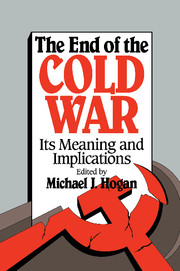Book contents
- Frontmatter
- Contents
- Preface
- The Authors
- Dedication
- 1 Introduction
- 2 An End to Which Cold War?
- 3 The Cold War, the Long Peace, and the Future
- 4 Quiet Cataclysm: Some Afterthoughts on World War III
- 5 Some Lessons from the Cold War
- 6 Nuclear Weapons and European Security during the Cold War
- 7 Victory in the Postwar Era: Despite the Cold War or Because of It?
- 8 The Wicked Witch of the West is Dead. Long Live the Wicked Witch of the East
- 9 The End and the Begining
- 10 A Balance Sheet: Lippmann, Kennan, and the Cold War
- 11 Why Did the Cold War Arise, and Why Did It End?
- 12 A View from Below
- 13 The End of the Cold War and the Middle East
- 14 The End of the Cold War in the Near East: What It Means for Historians and Policy Planners
- 15 After the Cold War: The United States, Germany, and European Security
- 16 The End of the Cold War: A Skeptical View
- 17 The End of the Cold War, the New Role for Europe, and the Decline of the United States
- 18 The Fading of the Cold War—and the Demystification of Twentieth-Century Issues
- 19 The U.S. Government, a Legacy of the Cold War
- 20 Foreign Policy, Partisan Politics, and the End of the Cold War
- 21 Beyond Bipolarity in Space and Time
- 22 A Usable Past for the Future
- Selective Bibliography
- Index
18 - The Fading of the Cold War—and the Demystification of Twentieth-Century Issues
Published online by Cambridge University Press: 18 December 2009
- Frontmatter
- Contents
- Preface
- The Authors
- Dedication
- 1 Introduction
- 2 An End to Which Cold War?
- 3 The Cold War, the Long Peace, and the Future
- 4 Quiet Cataclysm: Some Afterthoughts on World War III
- 5 Some Lessons from the Cold War
- 6 Nuclear Weapons and European Security during the Cold War
- 7 Victory in the Postwar Era: Despite the Cold War or Because of It?
- 8 The Wicked Witch of the West is Dead. Long Live the Wicked Witch of the East
- 9 The End and the Begining
- 10 A Balance Sheet: Lippmann, Kennan, and the Cold War
- 11 Why Did the Cold War Arise, and Why Did It End?
- 12 A View from Below
- 13 The End of the Cold War and the Middle East
- 14 The End of the Cold War in the Near East: What It Means for Historians and Policy Planners
- 15 After the Cold War: The United States, Germany, and European Security
- 16 The End of the Cold War: A Skeptical View
- 17 The End of the Cold War, the New Role for Europe, and the Decline of the United States
- 18 The Fading of the Cold War—and the Demystification of Twentieth-Century Issues
- 19 The U.S. Government, a Legacy of the Cold War
- 20 Foreign Policy, Partisan Politics, and the End of the Cold War
- 21 Beyond Bipolarity in Space and Time
- 22 A Usable Past for the Future
- Selective Bibliography
- Index
Summary
By now it is a commonplace that the “Cold War” is over, or at least radically altered. General Colin Powell, chairman of the Joint Chiefs of Staff, recently put it bluntly: “We have seen our implacable enemy of 40 years vaporize before our eyes.” The implications of the shattering events in the Soviet Union, however, are regularly misconstrued. The end of the Cold War is neither the great triumph that the Bush administration trumpets (“we have won”) nor the minor event that some on the Left suggest (“the old pattern of intervention will continue unchanged”). It is nevertheless extraordinarily important in three quite specific senses.
First, the collapse of the Soviet-American military stand-off clearly represents a significant, though still limited, coming to terms with the thermonuclear threat. The idea that nuclear weapons are useful (and moral) elements in a nation's international strategy, an idea born at Hiroshima, continues to persist, but there is a reasonable chance—give or take a decade, give or take a major scare—of moving toward a new wisdom that will relegate such weapons to something like the restricted status of poison gas. They exist, but they are less and less likely to be used, less and less “think-able.”
This is not the same, of course, as establishing a “new world order.“ As Paul Kennedy has suggested in The Rise and Fall of the Great Powers, we may simply see the emergence of a five-way balance-of-power system rotating around the United States, Europe, Japan, China, and what remains of the Soviet Union.
- Type
- Chapter
- Information
- The End of the Cold WarIts Meaning and Implications, pp. 207 - 216Publisher: Cambridge University PressPrint publication year: 1992



